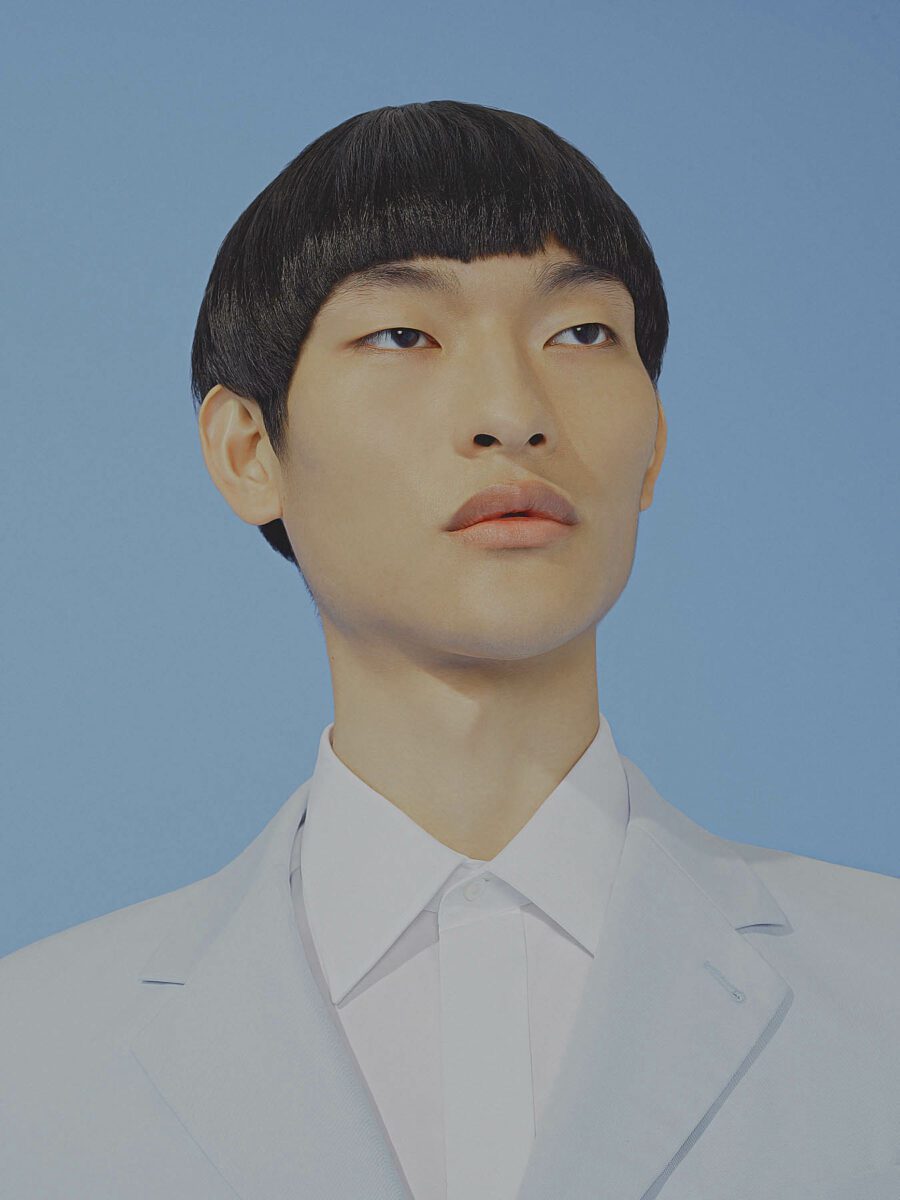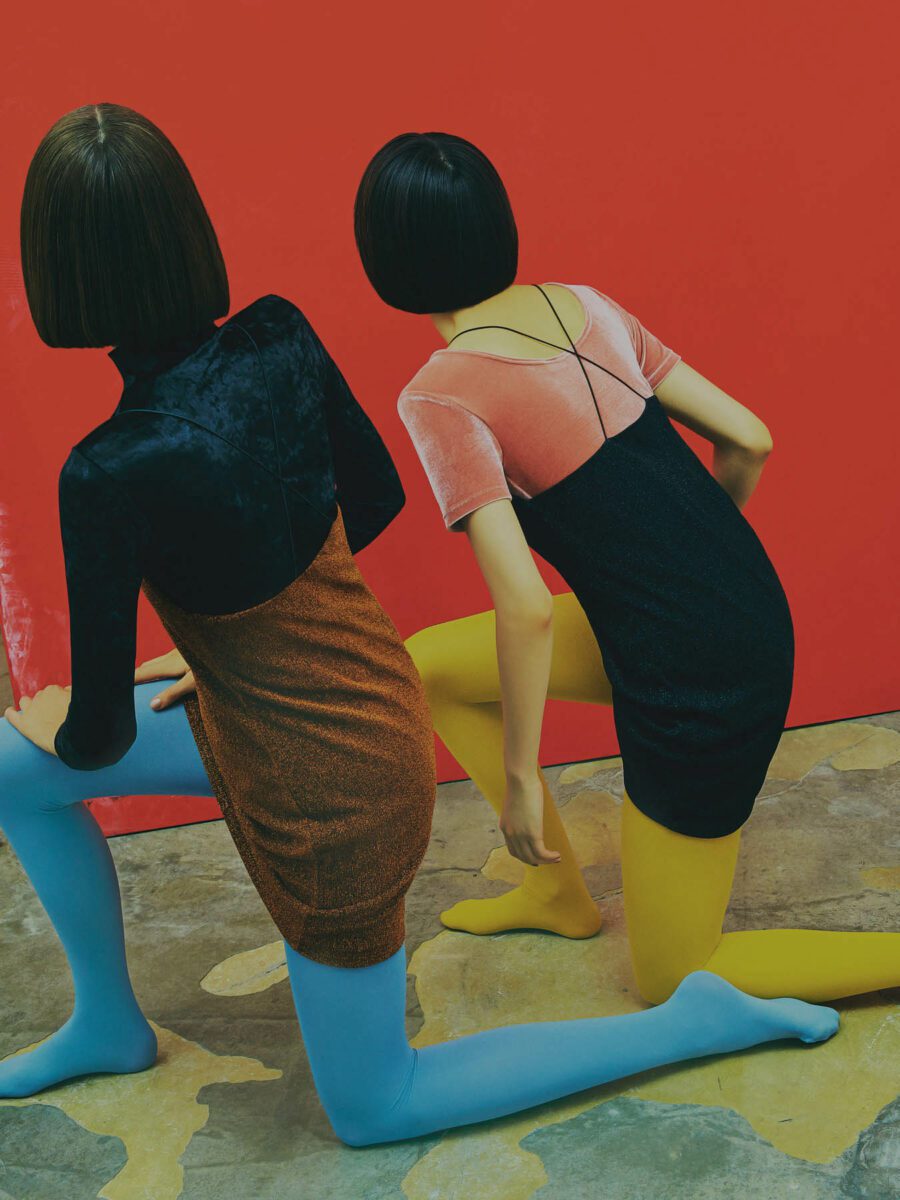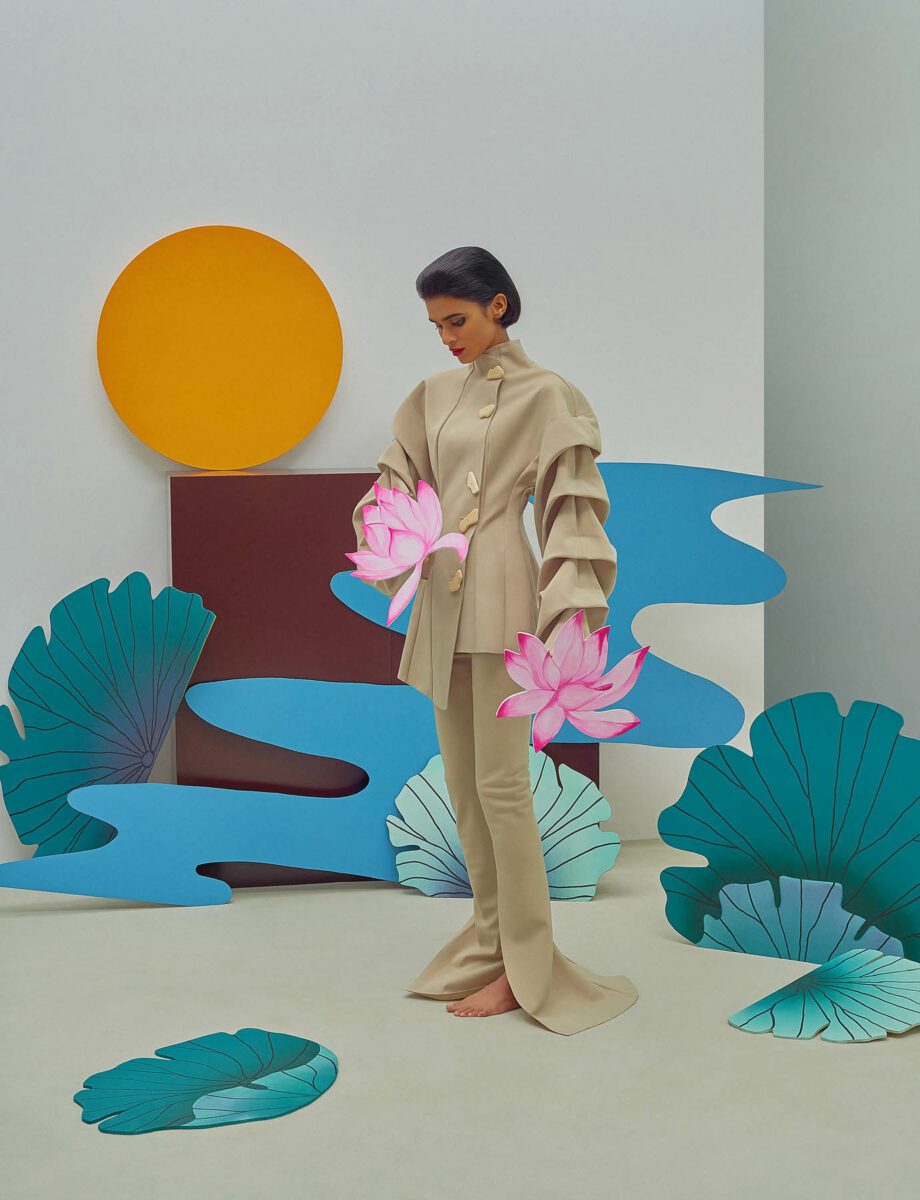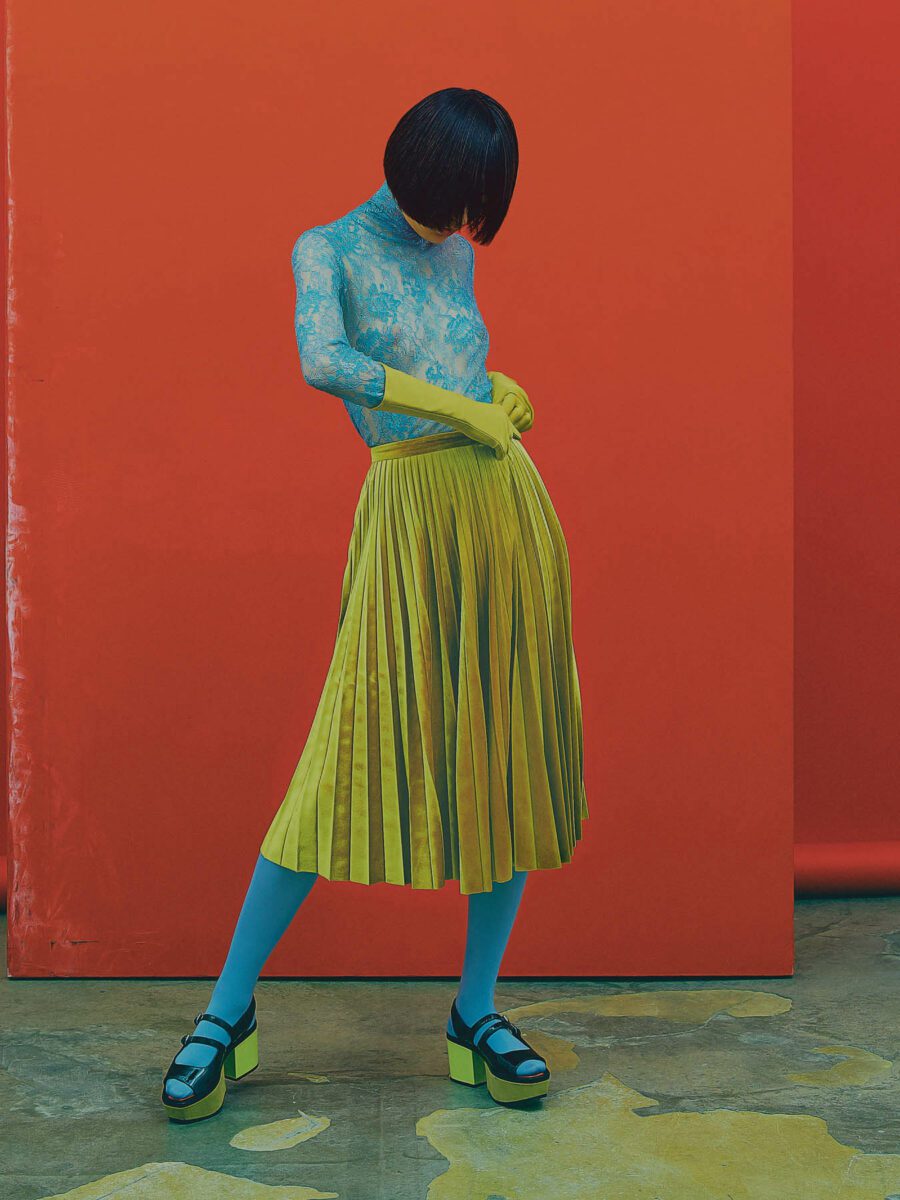Nhu Xuan Hua is a Parisian photographer based in London. She has worked with big brands – from Dior and Kenzo to Universal Music and Warp – but often draws from her Viet- namese heritage to produce subtly layered narratives. This autumn, Huis Marseille, Amsterdam, hosts a solo exhibition of works that reflect on colour, composition, tradition and identity, where bodies and objects become vessels for stories.
A: Tell us about your earliest experiences with art?
NXH: It started in a house in the suburbs of Paris: the one that saw me draw stories in my father’s painting studio. It was cold and humid in winter, and unbearably hot in the first days of June. It was also the garage for the car. In fact, it was the garage full stop. But my father turned it into a temple of art and other curiosities. One of the metal shelves carried all sorts of books and pots with brushes, which looked like jewels to my eyes. One of them was a tiny homemade photo frame, the size of my palm. It was a cut-out of a picture he took showing two flies mating. I got my first digital camera when I was 15: a small Konica Minolta with black-and-white, sepia and fuchsia options. I liked the distortion of reality those options allowed through colours. Then a classmate was intrigued by Photoshop in high school, and I remember being amazed when she would turn her arm into a snake.

A: You’ve been defined as a fashion photographer – is this how you see yourself? What visual language, or aesthetic identity, are you trying to create in your work?
NXH: I have always tried to set myself free from any sort of labels. As a child, whilst living in a traditional household, I was constantly reminded of my condition as a girl, being told what a girl should or shouldn’t do (and be). This puzzled me in many ways, as I have always wanted so much from life. I’m a bad decision-maker when I have to choose between two colours. I think that labels limit people from exploring their greater self and remaining under a sort of control. To be out of reach is the fear of any great authority; therefore, labels help to organise a system where people don’t try to move outside of that box. I still think the pursuit of one goal is equally respectable and honourable. I was brought up in a place where discipline and excellence were key, so having to set a strict agenda for my early 20s was a normal thing to do. I guess, I just had to make a decision for myself after my studies, and fashion photography came to me as the closest way to translate my stories whilst making a living out of it. I feel like my work, whether it’s fashion or not, is inhabited by many emotional layers and the narratives are inherently connected to my past and present. I see them as a conversation between two opposite sides trying to understand each other. I enjoy bringing poetry into a confrontational space.
A: Your wider artistic influences have included the likes of Max Ernst, Francis Bacon, Alberto Giacometti and Hans Bellmer. How do you bring these historical references into your images, balancing past and present?
NXH: Composition is key – I’m seeking visual balance. When you enter a Buddhist temple, there’s a perfect symmetry to the way the central shrines are displayed, with ornaments, flowers, fruits and statues. I can contemplate them for hours. My eyes are attracted by both the emptiness and the fullness, and I think my work functions with those two factions. It’s very much like a jigsaw puzzle of references, which are piled up to become one whole. My obsession for solving the un- known equation is contradictory with my will to find balance. I look at broken elements and spend a lot of time trying to piece them together, until I forget the presence of the glue that holds them. It sometimes seems like an impossible mis- sion. Most of the stories I create are a repetition of the same ideas on a loop. In recent years, most of the models have had similarities with many of the female figures in my family.

A: You often play with the human form, showing an understanding for lines and form, transforming the body into something less individualistic. In what ways are you trying to expand on the ways figures are represented?
NXH: A body is nothing without its story. One doesn’t carry the other, but both can glow because the other exists. I have been diving into my family history for some years now; the people that I get to photograph reflect my observations of my relatives’ features, even when I don’t purposely want to do this – somehow it finds a way to manifest. This can be through a hairstyle, a black kohl eyebrow drawn with care, legs positioned in a certain way or a hand gesture that says a lot about how the person feels. Your mind and soul are incredible vessels for transporting stories, whether these are ever told or if they’re kept inside. Examining the past means exploring relationships, whether physical or psychological. Our bodies are engines fuelled with care and love, but they are also fed with pain, which is equally important to portray.
A: Dalí once stated that “Surrealism is destructive, but it destroys only what it considers to be shackles limiting our vision.” What principles do you bring over from sur- realism and how do these form part of your wider ethos?
NXH: I like to see humans as creatures with supernatural powers, but these are being pulled back so the pyramid of obedience can be maintained. I’m a partisan of defiance – holding a motive driven by both love and anger. Surrealism is a playground where things can embody these notions. I say “things” not because I’m lacking words but because it really encompasses everything, from the most ordinary object to the most complex or abstract figure. I often trans- late the presence of love and relationships through many different aspects: foods like oysters and mussels, or elements of the house like curtains or glasses of water. During the first lockdown, I took the time to paint again – I realised how much the topic of love / couples / relationships were a fuel to my imagination. And I started seeing couples every- where: through a pair of gloves, or two trees standing alone in a valley. Pairing is a game to me; I notice that a lot of things come in pairs, and I like the idea that one thing cannot exist without another. And again, it works for everything: objects, emotions, people. I am a big believer of incarnations and soul travel. Maybe it is this that I am trying to translate.

A: You often work with recurring colour palettes – what do these shades signify, beyond their aesthetic appeal?
NXH: Colours are statements of sorts. They weigh as much as words translating a specific feeling. In a common universal language, we can all appreciate a bright blue sky for the sense of joy it conveys, as much as everyone knows that a pale blue sky often evokes a sense of calm or stillness. I think nature offers us definitions of emotions and states through colours, and that’s why those codifications have been used throughout cultures since the first stories ever told. In my process, the palette comes after drawing the initial contours of the narrative. A bright colour is what catches your attention first, so it calls you to enter the space, but it’s also important to maintain a sense of balance with this saturation and solidity. One cannot live without the softer shades also.
A: How important is your identity as a photographer? Where do heritage and tradition come into your works?
NXH: My recent series function thanks to my Vietnamese heritage and upbringing. The series you and me, the fish and the moon, for example, is a clear tribute to Vietnamese dance and opera, seen through the eyes of a person who’s discovering a culture and language. vows, oysters and tangerines and sharp tongue, round fingers provide more subtle references to childhood memories spent in France. I also think that sound holds an important place in the process. Heritage and traditions are passed on through storytelling most of the time, and they don’t necessarily have physical forms. Stories can take the form of a song or conversation.

A: Do you believe artists can create in a way that doesn’t speak of their socio-geographic-political position?
NXH: Our environment is hostile, yet filled with so much beauty. I want to believe that we must forgive humans for just being humans sometimes. Some days I can and some days I can’t. We live in a political environment, so our actions have an impact on others whether we want it or not. It’s pointless to think that you can avoid being part of the big picture. To evoke a sense of gratefulness or acknowledgement of the place we live in is part of any honest story and is told with the heart. I think that there is a big difference be- tween being angry and being violent when it comes to stand- ing up for your values. For me, a “positive” image is not to be seen as a piece of work from an idealist. It’s about being hopeful. This positivity is often used to counterbalance the darkest place one has happened to be in. For some, a vase with flowers can be purely decorative; for others, it means the world. Both perspectives are interesting and equally valid, as long as you question why the work gives you this impression.
A: What narratives are you crafting through this work?
NXH: The invitation to put a show together at Huis Marseille came when I needed to close a chapter in my own life. Hug of a Swan is the title of the exhibition; it is an imaginative tale where photographs are elevated into a dreamlike sanctuary across four rooms of the gallery. Overall, it is a tribute to both past and present worlds, as well as a last embrace before letting memories go. It’s a swan song for a departure with no return – a kiss on the forehead to past experiences, tales, lies and re-invented realities puzzled by life itself.
A: How do you see the future of fashion photography? What practices should we take into consideration?
NXH: People should accept the idea of being governed by slowness. Coming to terms with that idea would do everyone a lot of good, I think. The common ingredient to all practices – whether it’s photography, sculpture or painting – is time. It’s all about how generous you can be with it along the way.
Words: Kate Simpson
Nhu Xuan Hua Hug of a Swan | Huis Marseille, Amsterdam Until 4 December
Image Credits:
1. Nhu Xuan Hua, from the series Velvet (2016). Courtesy of the artist.
2. Nhu Xuan Hua, A Sort of Certitude (2018). Courtesy of the artist.
3. Nhu Xuan Hua, from the series Velvet (2016). Courtesy of the artist.
4. Nhu Xuan Hua, You, Me, the Fish and the Moon (2017). Courtesy of the artist.
5. Nhu Xuan Hua, from the series Velvet (2016). Courtesy of the artist.





